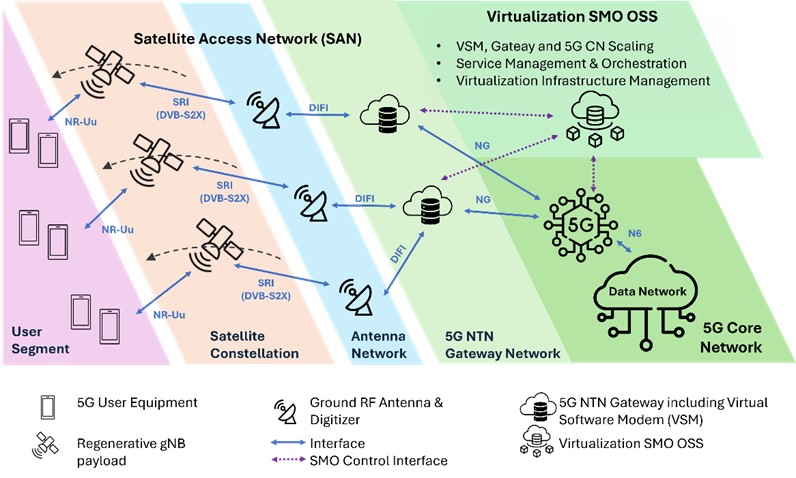
-
StatusOngoing
-
Status date2024-10-18
-
Activity Code6B.110
Targeting the definition phase, this feasibility study raised the Technology Readiness Level (TRL) from 2 to 3, with the following objectives
- Virtualised SATCOM Infrastructure: Develop a flexible, cloud-native infrastructure using modular, containerized microservices to manage satellite communication resources efficiently.
- Hardware-Agnostic Modem Design: Create software-defined modems capable of execution on various compute platforms (CPU, GPU, FPGA) to optimise adaptability, scalability, and resource utilisation.
- Standards Integration: Ensure seamless compatibility and compliance with key industry standards, including DVB-S2, 3GPP 5G NTN, and DIFI, enabling broad interoperability and future integration.
Since this feasibility study required multiple disciplines, including software development, SATCOM domain knowledge, signal processing, digitalization, and 5G/3GPP expertise etc., it presented many challenges.
- Balancing Performance and Virtualization: Achieving high-throughput, low-latency signal processing within virtualized environments, both cloud-based and COTS hardware setups.
- Latency Management: Addressing latency challenges beyond inherent satellite delays, including additional latency from digitalisation processes and signal transport over DIFI interfaces.
- Heterogeneous Compute Management: Ensuring seamless portability and unified control across CPU, GPU, and FPGA platforms.
- Complex Integration Requirements: Successfully integrating DVB-S2 IP communication with the 5G core (Free5GC), including the efficient en/de-capsulation between IP packets and DVB-S2 frames, adhering to diverse and evolving standards.
- Operational Observability: Developing effective real-time monitoring, diagnostics, and troubleshooting capabilities across distributed and virtualised system components.
The value proposition of ViSAGE is:
- Rapid Deployment: Enables fast provisioning, configuration, and operational readiness, significantly reducing time-to-market for new services and missions.
- Dynamic Adaptability: Offers dynamic deployment and redeployment capabilities across multiple cloud locations or platforms, ensuring optimal resource utilisation
- Scalable Performance: Ensures scalability and elasticity through modular microservices architecture, accommodating varying workload demands seamlessly.
- Mission Reusability: Facilitates reuse of modems and infrastructure across different missions through flexible, software-based reconfiguration.
- Cost Efficiency: Reduction of capital expenditures (CAPEX) by transitioning to operational expenditures (OPEX), leveraging cloud infrastructure and software virtualisation.
Certification and Compliance: Simplifies certification by allowing consistent use of the same software-defined modems through simulation, integration, testing, and operational phases, fully complying with DVB-S2, 3GPP, and DIFI standards.
The main product features are:
- Software-Defined Modems: Hardware-agnostic modem technology supporting dynamic execution across CPUs, GPUs, and FPGAs.
- Standards Compliance: Fully compliant with industry standards, including DVB-S2 for satellite communication, DIFI for digitalised RF signals, and 3GPP standards for 5G integration.
- Service Management & Orchestration: Service request management with optimised resource allocation planning and scheduling for efficient orchestration, provisioning and execution.
- Microservice-based Architecture: Modular and containerized components designed for scalability and independent deployment, managed through Kubernetes orchestration.
- Real-Time Monitoring and Diagnostics: Integrated observability and monitoring tools for real-time performance tracking and efficient troubleshooting.
- Cloud and On-Premise Deployments: Flexible deployment options enabling integration with existing infrastructure or fully cloud-based setups.
- Unified Web-Based Portal: User-friendly interface providing centralised management, configuration, and real-time performance metrics for operators and end-users.

The ViSAGE system employs an integrated architecture consisting of:
- Satellite Access Network (SAN): Utilizing DVB-S2X technology for efficient satellite communication, enabling transparent or regenerated data transmission between user terminals and ground infrastructure.
- Antenna Network: Incorporates Ground RF antennas and digitizers interconnected through DIFI interfaces for effective signal digitisation and forwarding.
- 5G NTN Gateway Network: Includes ViSAGE Virtual Software Modems (VSM) interconnected through DIFI interfaces to facilitate seamless integration with terrestrial 5G networks.
- Virtualization SMO OSS: Includes ViSAGE Orchestration and Management Platform, encompassing virtual software modem management, gateway scaling, service management, and virtualization infrastructure management.
- 5G Core Network: Fully integrated 5G core leveraging standard interfaces (N6), ensuring interoperability, compliance with 3GPP standards, and supporting advanced network functionalities.
This architecture ensures optimal flexibility, interoperability, and scalability, enabling effective management and dynamic deployment across satellite and terrestrial 5G domains.
-
User Need and State-of-the-art Analysis
-
System Requirements Review
-
Preliminary Design Review
-
Critical Design Review & Proof of Concept
-
Feasibility Phase Completion Review
This feasibility study has gone beyond paperwork to include proof-of-concept implementation. Bi-directional end-to-end communication between 5G-UE and 5G-N3IWF with VSM (DVB-S2) has been validated. Business Service Orchestration to simplify service ordering and provisioning has been deployed. A multi-platform approach to DSP development has been investigated.


